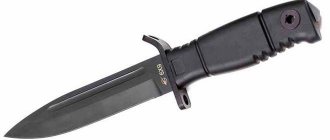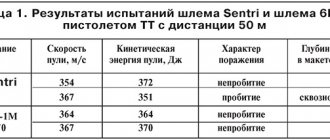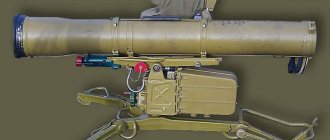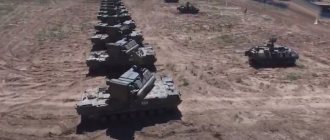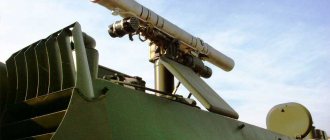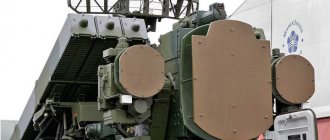Intelligence, control and communications complex "Strelets"
When solving a particular problem, the commander of an infantry unit must have contact with his soldiers, and also maintain the ability to exchange data with other units. Proper communication and management are key to the effective operation of the unit. To solve such problems, a special intelligence, control and communications complex (KRUS) “Strelets” was created in our country. In the recent past, this system has undergone modernization, which has ensured an increase in its basic characteristics.
KRUS "Sagittarius" was created by several Russian organizations and enterprises working in the field of radio-electronic systems. Project participants presented various components for various purposes, which then became part of a full-fledged complex. Now production samples of the Strelets are being manufactured by Radioavionics OJSC. Some development participants participate in production as suppliers of individual products.
The unit commander works with a tablet. Photo by the Russian Ministry of Defense
The development of the Sagittarius project was completed in the mid-2000s, and already in 2007 the army received the first samples of communication systems. Based on the results of the first years of operation in reconnaissance units of the ground forces, the Ministry of Defense compiled a list of necessary improvements. KRUS was modified taking into account the wishes of the personnel, as a result of which delivery of its improved version began. Several years ago, a deep modernization was carried out, which resulted in the new Strelets-M complex.
The Strelets and Strelets-M reconnaissance, control and communications complexes are an addition to the Ratnik army combat equipment. With the help of this equipment, fighters must maintain contact with each other and third-party “interlocutors,” perform reconnaissance and transmit data, etc. From the point of view of the main functions and capabilities of the Strelets KRUS, it is an addition and replacement for previously used voice communication radios used in ground units.
Components of "Sagittarius" of the first version. Picture Trcvr.ru
KRUS "Sagittarius" has a modular architecture and includes blocks for different purposes. The composition of the blocks used is determined taking into account the position and specialization of a particular fighter. Thus, a set for simple shooters has a reduced configuration, while a unit commander may need a full set of blocks. There are also several common blocks used in all trim levels. In total, six variants of the “Sagittarius” are offered, ensuring the work of fighters of different specializations.
The main “common” element of the complex is the platform unloading vest, to which all other devices are attached. Due to the available space, this vest can also be used with various pouches for other loads. Near the belt on the base vest the so-called. hardware container and battery container. Various remote controls and communication devices are proposed to be attached to the chest. The antenna devices of the complex's communications equipment are placed on the shoulders. During the recent modernization, engineers optimized the placement of individual elements of the complex, but the basic principles remained unchanged.
Placement of KRUS devices on an unloading vest. Photo Trcvr.ru
The key component of the Strelets KRUS is the AK-1 type hardware container. This product is a compact computer in a rugged design. Using a variety of cables, the AK-1 is connected to all other components of the system. It also supplies energy to the entire complex. The primary power supply container KPE-1 is responsible for supplying energy.
Communication within and outside the unit is carried out using the appropriate Sagittarius components. The fighter must use a telephone-microphone headset with voice communication and active noise reduction functions. Also, the standard computer of the complex is capable of transmitting and receiving data. Reception and transmission of radio signals is provided by an individual radio communication module (MIRS). Its antenna device is made in the form of a hemispherical block placed on the shoulder of the vest. A similar antenna device is used as part of the MSNS - satellite navigation system module.
Operational control panel. Photo Trcvr.ru
The POU operational control panel is placed on the chest of the unloading vest. This device has a set of buttons to control various functions of the Strelets KRUS. It is possible to turn it on and off, use the radio station, and also send emergency signals. The POU is designed in such a way that a soldier can use it as simply and effectively as possible, including without visual control.
It also provides for the use of a multifunctional MFP console and several types of commander consoles that allow solving relatively complex problems. Using these devices with a graphical interface and touch-button control, the unit commander can monitor the tactical situation, receive and transmit data, and control the actions of his soldiers. In addition, monitoring of the condition of soldiers is ensured, including timely detection of injuries.
In later versions of KRUS “Sagittarius”, full-fledged tablet computerized remote controls were introduced, intended for all fighters. Thus, the AK product has simplified functions and allows you to receive various information in a timely manner. It is also used as a data carrier and navigator. Commanders are encouraged to use the TT tablet with an expanded set of functions.
Command computer type "TT". Photo Vpk.name
Several existing radio stations are compatible with KRUS “Strelets” and “Strelets-M”, providing data exchange with other units or structures. For near-field communication, it is proposed to use the radio station R-853-V2M or R-168-5UN-2. There is a satellite communication station R-438-M. These tools are included in the kit of individual fighters.
The Sagittarius reconnaissance, control and communications complex is carried out in several versions, corresponding to the fighter’s specialization. First of all, basic and advanced kits are offered, including navigation, communications and target designation equipment. They should be used by riflemen as well as squad leaders. There are two versions of the complex with different radio stations offered for use by radio operators. A commander's kit with a full set of equipment and a rangefinder kit with a PDU-4 rangefinder and goniometer device have also been developed. The latter can be used to determine the coordinates of a target, and also has photo and video functions. Finally, the customer is offered the Fara-VR radar operator kit.
Depending on the configuration, a fighter’s KRUS “Strelets” or “Strelets-M” can operate continuously from the existing battery for 8-12 hours. Electronic equipment initially provided communication between fighters at distances of up to 1.5 km. Subsequently, the direct communication range was increased. The equipment of each soldier can also serve as a repeater, due to which the maximum communication range increases according to the configuration of such a “network”. It is also possible to interact with other ground- or air-based signal repeaters.
Product "TT". Photo Vpk.name
The PDU-4 rangefinder device provides observation and determination of object coordinates at ranges of up to 3-5 km. It has the function of taking photos and videos with transferring files to the unit commander. However, the use of these functions and the benefits from them are directly related to the current state of radio communications. In some situations, transferring a video file may be difficult and time-consuming.
Using the appropriate set of modules, the unit commander can monitor the location of his soldiers in real time, monitor their condition, and also transmit orders or receive reports. The remote tablet displays information in graphical form and is also capable of processing various commands and transmitting the necessary data to fighters throughout the entire range of communications. Soldiers, accordingly, can accept the commander’s instructions and report on their implementation using their simplified composition complexes.
The reconnaissance units of the ground forces were among the first in the Russian army to master the Strelets KRUS. With the use of new complexes, they are able to conduct surveillance, find various objects and guide aviation or artillery, or simply transmit data to headquarters.
Command tablet interface. Photo by the Russian Ministry of Defense
When solving reconnaissance tasks, the work of a unit equipped with Streltsy looks relatively uncomplicated. While at an observation position, a reconnaissance officer with the PDU-4 device must detect a target and determine its coordinates. Directly from the remote control-4, information about the target is transmitted via radio communication to the commander’s tablet. The latter can forward it to the artillerymen or contact close support aircraft and carry out target designation.
During the performance of other combat missions, the Strelets / Strelets-M complex to a certain extent simplifies the work of fighters. With its help, the commander can assign specific tasks to them, determine and forward movement routes, and also receive tactical information from various sources in a timely manner. All this greatly simplifies unit management and interaction on the battlefield, including with other units or structures.
***
The first samples of the Strelets reconnaissance, control and communications complex were transferred to the Russian army in 2007. The operators of this equipment were army intelligence units. Taking into account operating experience in the army, improvements and modernizations of both individual components and the entire complex were carried out. In addition, several years ago a new modernization was carried out, the result of which was the Strelets-M KRUS. Now the Russian armed forces are receiving new models of products with expanded functions and capabilities.
Rangefinder with PDU-4 device. Photo by the Russian Ministry of Defense
In 2013, it was reported that the army had 1,000 serial Strelets kits in service. As far as is known, in the future OJSC Rosavionika and related enterprises continued to produce such equipment, and its number in the troops was constantly increasing. Thus, a significant proportion of Russian ground units are equipped with new equipment and can solve combat missions with increased efficiency.
Since the end of the 2000s, first intelligence officers, and then representatives of other specialties, regularly used the Strelets / Strelets-M KRUS during various exercises. At the end of the last decade, the complex was tested as a target designation device for aviation and artillery. In particular, in practice they confirmed the possibility of effective interaction with existing front-line bombers and artillery systems.
The KRUS “Sagittarius” project implements several important ideas and solutions, with the help of which effective data exchange is ensured between soldiers and units, simplifying the solution of assigned tasks. To date, the Russian army has managed to receive significant quantities of such complexes and begin their full operation. Such equipment increases the combat effectiveness of units and has a positive effect on the condition of all armed forces.
Based on materials from the sites: https://vpk.name/ https://zvezdaweekly.ru/ https://bastion-opk.ru/ https://defence.ru/ https://tass.ru/ https:// redstar.ru/ https://function.mil.ru/
Application area
The Sagittarius security alarm system, thanks to its own developments, can operate in various climatic zones. Sensors and actuators function normally at temperatures from -30 to +55 degrees Celsius.
“Sagittarius” can work almost anywhere, from a small private house, cottage community to a huge factory. It is especially good where minimal impact on the security object is required. This could be a museum, an architectural monument, a room with a unique interior, or a logistics center with increased security requirements. “Sagittarius” is even installed on ships, which indicates its highest reliability.
Areas of use
The Strelets security complex, thanks to the foresight of its developers, is able to operate in almost any climate zone. The operating temperature range of the elements is between -30 and +50 C. The manufacturer guarantees that at these temperatures the complex will perform its functions without fail.
“Sagittarius” is equally well suited for any building format. The system can be installed both in a small cottage or private house, and in any warehouse with a huge area. “Sagittarius” is perfect for indoor use, and the customer requires minimal interaction with the protected object. This system is even installed on long-distance vessels, which once again confirms the highest level of operational reliability.
Advantages and disadvantages
The only drawback of the Strelets system in the early stages of production was the low level of protection of the radio channel from interference. However, this is long in the past. Modern versions use encryption mechanisms, which eliminated this drawback. Now the reliability of data transmission within the complex is not only not inferior to the level of wired systems, but even surpasses them. Wireless sirens allow you to implement any mechanism for alerting people: speech, sound or light signals. Due to the very wide range of equipment, the customer has the opportunity to create any system configuration based on their needs. Each element of the system has the ability to be precisely configured for the required tasks. This modularity allows the owner of the premises to reduce the cost of designing a security and fire system and the time required to install the system for a specific premises. It is also possible to change the architecture of the system in the future, if necessary, in case of redevelopment of the premises.
Stremyannye, Moscow, policemen...
As the Streltsy army developed, it was divided into three categories. The first among the regiments was Stremyannaya - the king’s marching guard, who accompanied him everywhere on the journey, being “at the stirrup”, which is why he got his name.
The stirrup regiment had double strength - its strength ranged from one and a half to two thousand. Unlike other archers, they lived near the Kremlin, in the White City, so that, if necessary, they would be ready to come to the defense of the sovereign.
Moscow archers formed the capital's garrison and lived in settlements outside the city. In the 1670s, 25 regiments with a total number of about 22 thousand soldiers were stationed in Moscow.
City archers served in provincial cities. They also settled in settlements and often detachments of one regiment were distributed among several garrisons. Traditionally, the Streltsy garrisons were considered city guards and were responsible for ensuring order in the streets.
The patriarchal archers were a special genus. They were subordinate to the Moscow Patriarchate, were considered the personal guard of the highest hierarchs of the church and were engaged in searching for priests and monks who behaved unworthily.
Sources[ | ]
- ↑ 12
“Igla” against “Stinger” and “Mistral” - This is interesting - Free Press - svpressa.ru - Man-portable anti-aircraft missile system 9K38 Igla | Rocketry (undefined)
. rbase.new-factoria.ru. Date accessed: November 29, 2016. - It is impossible to escape from the Russian Igla-Super MANPADS (unspecified)
(inaccessible link). Access date: February 22, 2010. Archived April 9, 2010. - "Igla" (9K38, SA-18, Grouse), man-portable anti-aircraft missile system Archived on February 11, 2011.
- The United States tried to prevent the supply of Russian MANPADS to Venezuela - WikiLeaks
- https://www.roe.ru/cataloque/air_craft/aircraft_118-121.pdf (inaccessible link)
- MANPADS "Igla-S" adopted by the Russian Army // AviaPort. Digest
- Support-launcher "Dzhigit"
- Set of control equipment and launch modules "Strelets" for MANPADS missiles of the "Igla" type
- Igla-V // Aviation encyclopedia “Corner of the Sky”
- Man-portable anti-aircraft missile systems (undefined)
. ru.uos.ua. Access date: April 18, 2016. - ↑ 123456789
Man-portable anti-aircraft missile system 9K38 "Igla" (Russian). Of. KBM website. Access date: January 20, 2012. Archived February 18, 2012. - ↑ 12345678
"Igla-S" (Russian). Of. KBM website. Access date: January 20, 2012. Archived February 18, 2012. - The Military Balance 2010. - P. 245.
- The Military Balance 2010. - P. 294.
- The Military Balance 2010. - P. 70.
- The Military Balance 2010. - P. 187.
- The Military Balance 2010. - P. 296.
- The Military Balance 2010. - P. 99.
- Lenta.ru: Weapons: Venezuela received 1,800 Russian missiles in 2009
- The Military Balance 2010. - P. 433.
- Russia submitted a report on supplies of conventional weapons to the UN Register IS "Rocketry"
- The Military Balance 2022. - P. 205.
- The Military Balance 2010. - P. 360-363.
- The Military Balance 2010. - P. 258.
- The Military Balance 2010. - P. 251.
- The Military Balance 2010. - P. 412-413.
- The Military Balance 2010. - P. 414.
- The Military Balance 2010. - P. 78.
- ↑ 12
Syria And Hezbollah Have Advanced Missiles | AVIATION WEEK (inaccessible link) - The Military Balance 2010. - P. 18.
- The Military Balance 2010. - P. 417.
- The Military Balance 2010. - P. 88.
- The Military Balance 2010. - P. 420.
- The Military Balance 2010. - P. 90.
- The Military Balance 2010. - P. 276.
- The Military Balance 2010. - P. 369.
- The Military Balance 2010. - P. 93.
- The Military Balance 2010. - P. 190.
- The Military Balance 2010. - P. 425-426.
- The Military Balance 2010. - P. 272.
- The Military Balance 2010. - P. 159.
- The Military Balance 2010. - P. 160.
- The Military Balance 2010. - P. 331.
- Fighting in El Salvador
- Aviation Contras
- Man-portable anti-aircraft missile system 9K310 Igla-1 | Rocketry
- Airframe Details for F-16 #84-1390
- MANPADS in local wars In the burning sky of Yugoslavia
- 31 Oct 95
- Incidents in Karabakh
- The last “Needle” of Chechen militants was confiscated (Date of access: April 15, 2011)
- Mi-26 was shot down from the Strela-2 anti-aircraft missile system Archived copy dated July 14, 2014 on the Wayback Machine
- Memory Page 1999—2007
- Archived copy (unspecified)
(inaccessible link). Retrieved October 27, 2014. Archived October 27, 2014. - An Egyptian helicopter was shot down by an Igla MANPADS - video - VPK.name
- Syrian revolution
- Devrimci Operasyon - Çukurca Sınır Hattı - 13 Mayıs 2016 - YouTube
Dress
According to tradition, dating back to the times of Ivan the Terrible, the archers wore a Russian caftan with a small stand-up collar and a colored cone-shaped hat with a fur band. Apparently, the first Streltsy had a red uniform, which was replicated in many paintings, books and films, but as the number of Streltsy regiments grew, a multi-colored uniform began to appear - special for each regiment. However, the distinctive feature of the Stremyanny Regiment throughout its existence remained the red color of its uniform, which was considered the most prestigious and characteristically military color in Rus'.
A document from the late 17th century, “Painting of Moscow regiments, how many regiments, and what caftans...” demonstrates that the archers wore white, crimson, yellow, green, brown, blue and light blue caftans, with each color corresponding to several shades. The caftan was fastened with round or oblong buttons. The clasps on the chest were trimmed with gold or colored cords. By the way, such stripes, which many consider almost an obligatory part of the Streltsy uniform, were not worn by all regiments.
The officers wore uniforms made of the best quality cloth, with belts embroidered with gold, and expensive fur, which was used to trim hats and caftans. Their buttons were made of precious metals, and the chest trim was made of gold cords and braid with tassels. There is a hypothesis that Streltsy officers had a small crown embroidered on their hats, but no convincing evidence has yet been found.
“Colored dress” and hundreds of banners of the Moscow Streltsy orders, 1674
Mandatory part of combat training
Let us note that recently, practicing actions using the Strelets KRUS has become a mandatory element of combat training of units and formations of the Armed Forces of the Russian Federation.
Here is a chronicle of just last week.
June 10th. In North Ossetia, motorized riflemen of the 55th Combined Arms Army are practicing the use of “roaming” mortars mounted in the back of KamAZ vehicles at a training ground. Detection of targets, their additional reconnaissance and issuance of target designations is carried out using drones and the Strelets KRUS.
facebook.com / Russian Ministry of Defense
June 11. The peacekeeping motorized rifle brigade is conducting an exercise at the Roshchinsky training ground near Samara to repel an attack by illegal armed groups on checkpoints in the buffer zone. The situation was monitored using Orlan-10 and KRUS Strelets drones.
June 14. At the Kara-Khaak training ground near Kyzyl, personnel of the 55th separate motorized rifle mountain brigade are practicing the use of Leer electronic warfare and electronic reconnaissance systems, as well as the Strelets KRUS.
June 17. The Russian Ministry of Defense reports that tests of the newest Mi-28NM attack helicopter have been successfully completed in Syria. Its avionics make it possible to integrate this “turntable” into the reconnaissance and strike contours of ground forces, including the Strelets KRUS.
June 18. Scouts from the motorized rifle brigade of the Southern Military District, stationed in the Republic of Dagestan, began performing tactical and special tasks at the Dalniy training ground as part of field training. Particular attention is paid to improving the skills of using the Strelets KRUS.
And so on and so forth.
facebook.com / Russian Ministry of Defense
Other modifications[ | ]
- Igla-D
is a variant with a collapsible launch tube for the Airborne Forces. - Igla-V
- for arming helicopters and ground vehicles[10]. A block has been added that provides the ability to share two missiles. - Igla-N
- a new missile defense system was used, with a more powerful warhead, which significantly increases the likelihood of hitting targets. - Igla-1M
,
“336-24”
- Ukrainian modifications of MANPADS “Igla-1”, “Igla”, with an improved missile seeker (increased range and noise immunity), developed by Ukroboronservice[11].
In service[ | ]
Operators of MANPADS "Igla-1" and "Igla"
Play media file
Use of 9K338 Igla-S during exercises 9K338 Igla-S MANPADS 9K38 “Igla” in the Brazilian Armed Forces.
- Azerbaijan
- Armenia
- Algeria - Igla-1 MANPADS, as of 2010[14]
- Angola - Igla-1 MANPADS, as of 2010[15]
- Belarus - MANPADS "Igla-1" [ source not specified 4044 days
] - Brazil - 53 MANPADS, as of 2010[16]
- Bosnia and Herzegovina - Igla-1 MANPADS, as of 2010[17]
- Botswana - 10 Igla-1 MANPADS, as of 2010[18]
- Venezuela - 200 Igla-S MANPADS, in service with the Air Force, as of 2010[19] 1800 missiles[20]
- Vietnam - MANPADS "Igla-1" and "Igla", as of 2010[21]
- Egypt - 656 Igla-S MANPADS launchers were delivered in the period 2008-2011, the total number of MANPADS purchased under the 2005 contract is not known[22]
- Georgia - some, as of 2017[23]
- India - a significant number of Igla-1 and Igla MANPADS, as of 2010[24]
- Jordan - MANPADS "Igla-1" and "Igla", as of 2010[25]
- Iran - Igla-1 MANPADS, as of 2010[26]
- DPRK - a significant number of Igla-1 MANPADS, as of 2010[27]
- Republic of Korea - Igla-1 MANPADS, as of 2010[28]
- Cuba - Igla-1 MANPADS, as of 2010[29]
- Lebanon - In 2012, Hezbollah received a shipment of Igla-S MANPADS from Iran[30]
- North Macedonia - Igla-1 MANPADS, as of 2010[31]
- Malaysia - as of 2010[32]
- Mexico - more than 5 MANPADS, as of 2010[33]
- Myanmar - as of 2010[34]
- Nicaragua - Igla-1 MANPADS, as of 2010[35]
- UAE - Igla MANPADS, in service with air defense forces, as of 2010[36]
- Pakistan - Igla-1 MANPADS, in service with the Air Force, as of 2010[37]
- Peru - 128 Igla-1 MANPADS, as of 2010[38]
- Transnistria - MANPADS "Igla" [ source not specified 3792 days
] - Russia - Igla-S 9K338 MANPADS as of 2022 are in service with the Russian Armed Forces, together with the Verba MANPADS.
- Gaza Strip - In 2012, Hamas received a shipment of Igla-S MANPADS from Iran[30]
- Serbia - 54 SA-16 Šilo
, as of 2010[39] - Singapore - Igla MANPADS, as of 2010[40]
- Syria - significant number of Eagles, as of 2010[41]
- Slovakia - Igla-1 MANPADS, as of 2010[42]
- Slovenia - 96 MANPADS, as of 2010[43]
- Uganda - Igla-1 MANPADS, as of 2010[44]
Additional equipment[ | ]
OPU "Dzhigit"[ | ]
OPU "Dzhigit" on the chassis of the Mercedes-Benz Unimog of the Mexican Navy.
Combined installation of the Kazakh Ground Forces from ZU-23-2 with the Igla air defense system on the chassis of a KAMAZ vehicle. The main advantage of the Dzhigit support-launcher is the possibility of salvo launch of missiles by one shooter. “Dzhigit” is equipped with two “Igla” launchers, a “friend or foe” external preliminary target designation system, means of its own diagnostics and maintenance, as well as educational and training facilities[8].
With a salvo launch of missiles, the probability of hitting a target increases on average by 1.5 times.
Set "Sagittarius"[ | ]
Set of equipment and launch modules 9S846
“Strelets” is designed to provide automated remote single, sequential launch of “Igla” missiles from various land, air and sea-based carriers.
When two or more modules are placed on a carrier, salvo launches of two missiles at one target are possible.[9].

